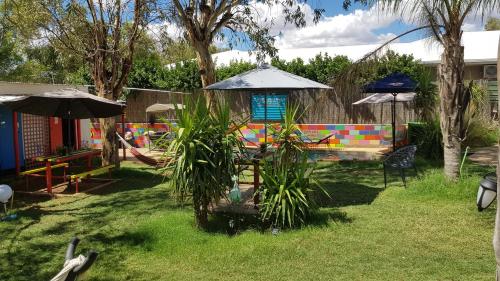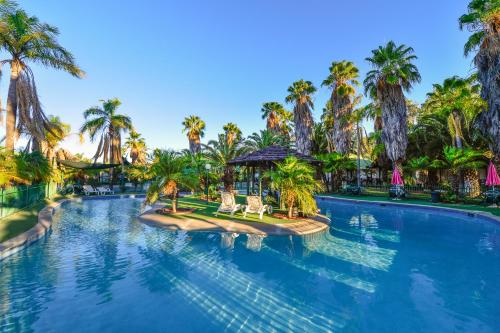It’s hard to imagine, with Central Australia so hot and dry these days. But many millions of years ago, the land here was actually covered by a vast inland sea, inhabited by strange prehistoric marine animals.
In fact, there have been lots of strange animals that have made their home over the years in the Red Centre (perhaps before it was even that red).
50,000 years ago, megafauna lived in this part of the continent – including a lion that was related to wombats, an emu-like bird that was up to three metres high, and a freshwater crocodile weighing up to 800 kilograms!
Even today, the animals found around Alice Springs are fascinating, from the elusive marsupial mole to the rather dangerous-looking thorny devil.
All of this (and more) is the focus of the Museum of Central Australia, which traces the natural history of the region from the creation of the universe, through ancient eras, right up to modern day.
While much of the natural focus of a visit to Alice Springs these days is on the ochre landscapes that you’ll see around you, there’s a lot of context in the deeper geological story behind them.
The MacDonnell Ranges, for instance, was once a series of enormous mountains as high as the Himalayas, which have been eroded down over millions of years to what you find today.
When you head out of the city and hear Aboriginal stories passed down for generations about huge mountains, it gives you something to think about (especially seeing as our current understanding of the Indigenous timeline wouldn’t really line up with the slow pace of erosion).
My point is that the Museum of Central Australia has lots of little interesting tidbits about this part of the country. While the museum is probably not going to be a highlight of your visit to Alice Springs, it plays an important role in telling the story of this part of the Northern Territory.
What’s here?
There are two main sections to the Museum of Central Australia. The larger area that covers the lower floor is dedicated to natural history.
There are displays about the geology of Central Australia that explain the history chronologically. As you go around, the topic turns more to the evolution of animals.
In one exhibit, there’s the enormous skull of the ‘baru’, the 800-kilogram freshwater crocodile that ruled the waterholes until it became extinct about 30,000 years ago.
In another, there are examples of all the scary snakes and lizards that still exist out there in the desert today.
One of the more interesting parts of this section are the taxidermy specimens of the range of mammal species that live in the Red Centre. Many of them you’ll never see in person, so the display is quite helpful. And some of them are in rather weird positions (the taxidermy cat, for example) and that’s amusing enough in itself!
The other section of the Museum of Central Australia, on the upper level, is smaller, and currently has an ongoing photography exhibition called A Frontier Journey.
The photos were all taken between 1915 and 1918 by Otto Tschirn, who spent much of the early 20th century in Central Australia.
In particular, his old black-and-white photos capture life at the mission at Hermannsburg and show the everyday interaction between the Aboriginal and non-Aboriginal people living there at the time.
How to visit?
The Museum of Central Australia is part of the Araluen Cultural Precinct, which acts as a hub for some of the most important institutions in Alice Springs.
Reaching the museum is easy by car and also possible by public transport from central Alice Springs. You could even walk there, but you would want to avoid the hottest part of the day.
The museum is not large and it doesn’t take too long to see it – although exactly how much time you spend here would depend on how much detail you want to read. I would suggest the average visitor would be done within 30 minutes.
Where is the Museum of Central Australia?
The Museum of Central Australia is in the Araluen Cultural Precinct, about two kilometres west of the central Alice Springs. The official address is 4 Memorial Avenue, Gillen, NT, 0870.
You can see it on a map here.
How do you get to the Museum of Central Australia?
If you have a car, the Museum of Central Australia is just a five-minute drive from the centre of Alice Springs, and there’s lots of free parking.
By public transport, you can catch bus 400 or 401. (Routes and timetables are here.)
Or it’s about a 25-minute walk from the centre of town (although you may want to avoid that when it’s hot!).
When is the Museum of Central Australia open?
The Museum of Central Australia is open at the following times:
Tuesday to Friday: 10:00 – 16:00
Saturday and Sunday: 10:00 – 14:00
The museum is closed on Monday.
What is the Museum of Central Australia entry fee?
General entry to the Museum of Central Australia is $8.
Concession: $6
Family (2 adults/3 children): $20
Northern Territory residents: Free
You can find more details on the official website of the Museum of Central Australia.
And just a reminder that the museum is closed on Monday.
Is it worth it?
Although it’s not at the top of the list of things to do in Alice Springs, there are certainly things of note in the Museum of Central Australia for people interested in natural history.
The exhibition space is relatively small, with most of the natural collections on display in just one gallery. But some of the cabinets contain a lot of interesting specimens – particularly those with the region’s current fauna.
The megafauna exhibit is fascinating, but you can learn all of that (and more) at the Megafauna Central section of the museum in the city centre.
The location of the Museum of Central Australia certainly makes it convenient to combine with a visit to some of the other places in the Araluen Cultural Precinct.
The main question is probably whether you think there will be enough interest for you to justify the entry fee.
What’s new?
Unlike some of the Northern Territory’s museums, the Museum of Central Australia doesn’t normally host any temporary exhibitions.
There is currently nothing new on display or planned at the museum.
What else?
The Museum of Central Australia is part of the Araluen Cultural Precinct, which has a few different things to see while you’re here.
The main attraction is the Araluen Arts Centre, which has a theatre and an art gallery. The gallery has four spaces that show temporary or travelling exhibitions, as well as a selection from the permanent collection – including some original Albert Namatjira paintings.
Next door, you’ll find Central Craft, a small gallery and shop with contemporary crafts like jewellery, weaving, ceramics, and woodwork. And to get there, you’ll go through the interesting Yeperenye artwork.
Also within the Araluen Cultural Precinct, you’ll find the Central Australian Aviation Museum, on the site of an aerodrome from the 1940s. There are a number of heritage aircraft in the hangars, along with an interesting collection of equipment.
And as you walk around the precinct, you’ll probably also notice quite a few public art pieces – some large and obvious ones, but also smaller murals and pieces that have been added recently.
THE BEST ACCOMMODATION IN ALICE SPRINGS
Although there isn’t lots of accommodation, at least there’s a wide range. Have a look at my detailed story about where to stay in Alice Springs, or I’ve got a few of the top suggestions here.
BACKPACKER

In a convenient location, Alice’s Secret Travellers Inn has a relaxed vibe, and outdoor space, and can book good tours for you.
SELF-CONTAINED

The self-contained villas at Desert Palms are situated in a lovely little oasis with a great pool.
UNIQUE

Although it’s a bit of a drive from town, the Ooraminna Homestead offers a really special Outback experience.
LUXURY

Of the nicer hotels in the city, I think the DoubleTree by Hilton has the most to offer, including a more secure complex.